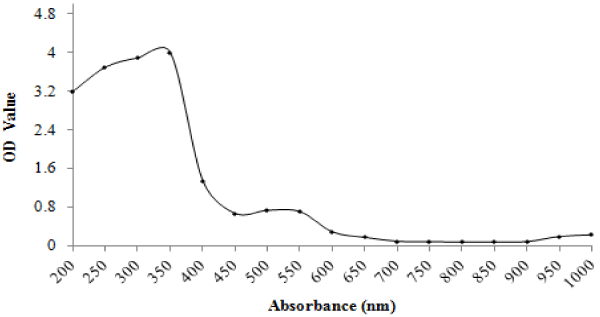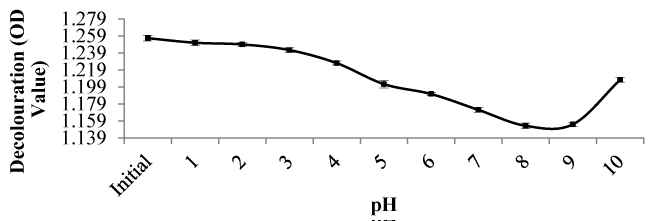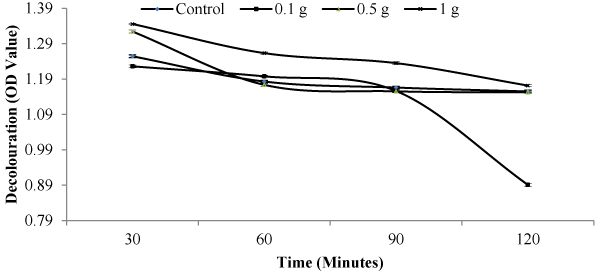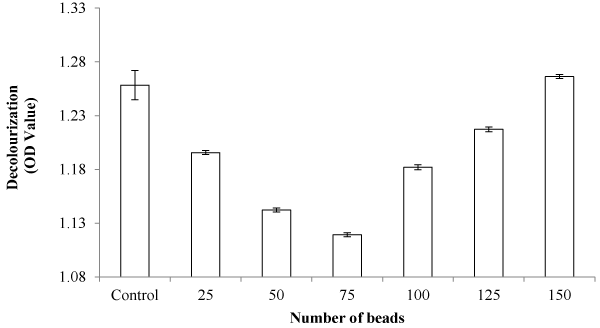Research Article Open Access
Optimization of pH, Retention Time, Biomass Dosage in Beads and Beads Density on Textile Dye Effluent Bioremediation using Seagrass, Cymodocea rotundata Beads
| Soumya GN1, Manickavasagam N1, Santhanam P2*, Dinesh Kumar S2, Vasanthi D3 and Karuppasamy PK3 | |
| 1Department of Biotechnology and Genetic Engineering, School of Life Sciences, Bharathidasan University, Tiruchirappalli-620 024, India | |
| 2Marine Planktonology and Aquaculture Lab., Department of Marine Science, School of Marine Sciences, Bharathidasan University, Tiruchirappalli - 620 024, India | |
| 3P.G. and Research Department of Zoology, Periyar E.V.R College, Tiruchirappalli-620 023, Tamil Nadu, India | |
| Corresponding Author : | Santhanam P Marine Planktonology & Aquaculture Lab Department of Marine Science, School of Marine Sciences Bharathidasan University, Tiruchirappalli-620 024 Tamil Nadu, India Tel: +9198942-23482 Fax: +91431- 2407045 E-mail: sanplankton@yahoo.co.in, santhanamcopepod@gmail.com |
| Received March 26, 2015; Accepted May 27, 2015; Published May 29, 2015 | |
| Citation: Soumya GN, Manickavasagam N, Santhanam P, Dinesh Kumar S, Vasanthi D, et al. (2015) Optimization of pH, Retention Time, Biomass Dosage in Beads and Beads Density on Textile Dye Effluent Bioremediation using Seagrass, Cymodocea rotundata Beads. J Bioremed Biodeg 6:295. doi:10.4172/2155-6199.1000295 | |
| Copyright: © 2015 Soumya GN, et al. This is an open-a ccess article distributed under the terms of the Creative Commons Attribution License, which permits unrestricted use, distribution, and reproduction in any medium, provided the original author and source are credited. | |
Related article at Pubmed Pubmed  Scholar Google Scholar Google |
|
Visit for more related articles at Journal of Bioremediation & Biodegradation
Abstract
Laboratory experiments were performed to study the removal of dye from textile effluent using the seagrass Cymodocea rotunda beads in calcium alginate. The present experiment was conducted to know the effects of pH, beads density, retention time and biomass dosage in beads on dye removal from textile effluent. Algal uptake and adsorption on alginate gels were the major principals involved in the removal of nitrate and phosphate from effluent. Increasing cell stocking in beads did not cause any improvement in the efficiency of treatment, but caused some leakage problems. Also, the increased beads concentration in effluent caused reductions in light penetration and enhanced self-shading effects besides the beads settled at the bottom of the reactor. The experiment inferred that the 75 numbers of algal beads with pH 8 in the biomass dosage of 0.1 g and 120 minutes retention time were found to be suitable factors for the effective removal of dye from the textile effluent.
| Keywords |
| Textile effluent; Bioremediation; Bio-sorption; Sea grass; Cymodocea rotundata |
| Introduction |
| Most important pollutant in effluent from food processing, cosmetics, paper, dye manufacturing, printing and textile are colour left by dyes [1]. In the middle of these, textile industries consume large volumes of water and chemicals for wet processing of textiles [2]. The waste from the dying operations in the textile industries may contain dyes of various intense colours, such as dyes having the functional groups of alkene, aromatic, C-N bond, S-O bond of red colour. Some are made by inorganic molecules such as Al-O, Si-O, K-O, N=N bond which responsible for colour development in the effluent. The conventional effluent treatment systems are unable to remove recalcitrant dyes from the effluents. The removal of dyes from effluents by the physico -chemical means such as membrane filtration advance oxidation, photo catalysis, coagulation and adsorption are often very costly and accumulation of concentrated sludge creates a disposal problem [3-7]. There is a need to find alternative methods of dye removal from large volumes of effluents at low cost. Biological or combination systems can fulfil these requirements. Many dyes are difficult to decolorize by adopting physical and chemical remediation due to their chemical structure and synthetic origin. Biological processes are getting more attention as they are cost effective, environment friendly and do not produce large amount of sludge. Among biological processes, the adsorption technique is dreadfully attractive because of its, economic feasibility, simplicity of system design, good efficiency and easy operation and handling [8]. In recent years, a number of studies have focused on immobilized microorganisms that are able to decolorize dyes in textile effluents [9-12]. These studies have shown that high capacities can be achieved. This suggests that the technique of cell matrix is a viable alternative for dye decolorization. The immobilization of dye removing microorganisms provides important advantages, such as exposure to higher dye concentrations without loss of cell viability, a better environment for dye removal activity, and protection of microorganisms against changes in temperature, pH, and other toxic compounds of effluent [13]. Present study was carried out to know the decolourization efficacy of seagrass, Cymodocea rotundata beads on textile dye effluent. |
| Materials and Methods |
| Collection of seagrass and preparation of biosorbent |
| The healthy of seagrass Cymodocea rotundata was collected from Palk Bay, Muthukuda coastal waters (Lat. 9° 51’ 48’’ N; Long 79° 7’ 15’’ E). The biosorbent powder was prepared using standard method [14]. The algae was washed twice with running tap water and then thoroughly rinsed with distilled water to remove particulate matter and salts from the surface. Then the biomass was shade dried and later dried at 60°C for 24 hours using hot air oven. The dried biomass was subsequently grounded with mortar and pestle and sieved to a particle size of 500- 850 μm and then stored in desiccator for bio sorption experiment. |
| Characteristics of dye effluent |
| The textile effluent was collected from local dyeing factory located at Karur, Tamil Nadu, India. The pH, salinity and the nutrients such as NH3-N, PO4-P, NO3- -N, were also analysed before the experiment. The physico-chemical parameters such as colour, TH, CH, were determined as soon as the sample was brought to the laboratory. The physical and chemical parameters of textile dye effluent (TDE) (Initial and final) were determined using standard methods [15-17]. |
| Spectrophotometer analysis |
| The preliminary scanning was performed between 200 and 1000 nm using UV-vis spectrophotometer (1800 Shimadzu UV) to determine the maximum absorbance (λ max) wavelength of the diluted (1:10) untreated textile effluent [18]. This dye effluent showed (λ max) maximum absorbance at 350 nm (Figure 1). |
| Preparation of seagrass beads |
| The seagrass beads were prepared according to Santos et al. [19]. To prepare 100 ml of alginate solution 4 g of alginate was first carefully dissolved by stirring in 70 ml of distilled water. In the remaining 30 ml of distilled water, 3.5 g of NaCl were dissolved to obtain 3.5 g/l salinity final solution. When the alginate was completely dissolved, the two parts were mixed in magnetic stirrer. Cation solutions were prepared in nanopure water. Beads were prepared by adding a drop of alginate solution, by means of 20 ml of syringe (0.8 mm×40 mm needle, Braun, Melsunger, Germany) into the cation solution, from a height approximately one drop per second. The beads were kept stirring in the cation solution for 45 minutes to allow complete hardening of the alginate and washed several times with filtered (0.45 m) natural seawater to eliminate the remaining cation. |
| Decolorization experiment |
| The decolorization of the dye was carried out in 250 ml conical flasks. About 25 ml of dye effluent was taken into flasks. A known number of algal beads (100 Nos.) were inoculated that the flasks were kept in static condition for 120 minutes at room temperature to occur decolorization. After stipulated interval, the sample was subjected to determine the percentage of decolorization. The decolorization was determined by monitoring the decrease in absorbance at the maximum wavelength of the dye (350 nm) by using a Spectrophotometer (1800 Shimadzu UV). The separate experiment was conducted on the removal of color from dye effluent by considering various parameters such as effect of pH, time, biomass dosage in beads and beads density as described by Telke et al. [20]. |
| Effect of pH, retention time, biomass dosage in beads and beads density |
| To know the optimum pH, the pH ranges between 1 and 10 was maintained for the removal of dye using seagrass beads. The pH of the each dye effluent was adjusted using diluted NaOH and HCL (ELICO, INDIA). Similarly, a different retention time viz., 30, 60, 90 and 120 minutes were chosen for the dye removal experiment. The 250 ml conical flasks filled with dye effluent and seagrass beads were kept in static condition at 30°C. At the end of the experiment, the beads were isolated and the effluent was subjected for spectrophotometric reading using 1800 Shimadzu UV. To standardize the biomass dosages, different dosages of seagrass biomass such as 0.1 g, 0.5 g and 1 g were used for the beads preparation and subsequent adsorption processes. To optimize the beads density, different beads density viz., 25, 50, 75, 100, 125 and 150 were used for the adsorption process. |
| Decolorization |
| All decolorization experiments were performed in triplicate and textile dye decolorization was calculated using following formula: |
 |
| Statistical analysis |
| The mean and standard deviation values of the triplicates for each treatment were calculated. The parametric one-way analysis of variance (effect of beads density and pH) and two-way analysis of variance (effect of time and biomass dosage in beads) was used to evaluate the effects of the different bioreactors at particular treatment time. Turkey and Fisher LSD test was used when the ANOVA result showed a significant difference among the treatments at P<0.05. The origin program version 8 was used to study the simple statistics and analysis of variance (ANOVA) of the different treatment. |
| Results |
| Effect of pH on decolouration of textile effluent |
| The initial concentration of colour in the effluent was reduced significantly with respect to pH (1-10). The maximum colour reduction (0.104 nm) was observed at pH 8 while the minimum colour reduction (0.004 nm) was recorded at pH 1 (Figure 2). The reduction in colour by seagrass beads were significantly (P<0.05) better than control beads. The differences in the efficiency of colour removal between the pH 1, 2 and control were not significant (P>0.05) whereas other pH was found highly significant (p<0.05). At pH 8, the percentage of colour removal was recorded to be high (8.26%) till 2 hours; thereafter the percentage of decolouration was decreased proportionally. The pH 8 resulted the maximum decolouration compared all other pH tested presently (Table 1). |
| Effect of biomass dosage in beads and retention time on decoloration of textile effluent |
| The experiment was conducted to know the biomass dosage in beads and retention time. In this experiment, the colours were reduced significantly. The experiment was lasted for 2 hours and the samples were collected every 30 minutes interval. Here the pH was maintained at 8 during the whole experiment time. The maximum colour removal was recorded at 0.1 g dosage at 120 minutes incubation while the lowest removal was observed at 1.0 g at 120 minutes incubation. The overall ANOVA at 0.05 level (p < 0.05), the population means of factor A (Biomass dosage in beads) and factor B (Retention time) are significantly different. The turkey test, except 2 relation [(without and 0.5 g containing beads) and (0.5 g and 1 g containing beads) showed significant at 0.05 level. Earlier described relation is not significant at the 0.05 level. In time test (Turkey test) except 60 and 90 minutes retention time, all retention time were significantly related. |
| Effect of beads density on decolouration of textile effluent: |
| The decolorization with respect to beads density (25, 50, 75, 100, 125 and 150) conducted presently, colour removal was found to be higher when the effluent treated with 75 numbers of beads (Figure 3) while other beads density resulted significantly low colour reduction. In the present study, the data were analysed with one way analyses of variance, which show the means of one or more levels are different. At 0.05 levels, the population means are significantly different. The turkey and fisher LSD test clearly described that the 25-100 and control 150 number of beads density was not significantly different to 0.05 levels whereas others are highly significant at 0.05 levels. |
| Efficacy of sea grass beads on nutrients removal form textile effluent |
| Presently, dye effluent was also subjected to ammonia, silicate, phosphate, nitrite and nitrate removal experiment done with initial values of 20.11 μmol/l, 74.58 μmol/l, 10.13 μmol/l, 17.94 μmol/l and 14.31 μmol/l respectively (Figure 4). Among the nutrients studied, the highest removal was found in nitrate which removed nearly 13.821 μmol/l from the total concentration of 14.31 μmol/l. Incase of phosphate removal, the concentration was decreased from 10.13 μmol/l to 6.49 μmol/l. The significant reduction was also noticed in nitrite which was reduced from 17.93 μmol/l to 5.53 μmol/l within the two hours of experiments. A stumpy reduction was noticed in ammonia which was reduced to 21.17 μmol/l from initial concentration of 47.36 μmol/l. Similarly the silicate concentration also decreased significantly from an initial concentration of 74.58 μmol/l to 60.67 μmol/l. |
| Discussion |
| The contaminants such as acids, bases, toxic organic and inorganic dissolved solids, and colours were considered as the most undesirable compounds and are mainly caused by dyes [21]. Dyes are synthetic aromatic water-soluble dispersible organic colorants, having potential applications in various industries. The dye usage has increased nowadays because of tremendous increase of industrialization and man’s urge for colour [22]. Dyes tectorial value is high: less than 1 ppm of the dye produces obvious coloration [23]. Removal of colour from dye bearing effluent is a complex problem because of difficulty in treating such effluents by conventional treatment methods [24]. |
| According to pervious literature [12], bio-decolourization of dyes recorded due to adsorption to biomass or biodegradation. In adsorption process, the absorption spectrum revealed that all peaks decreased approximately in proportion to each other. If the dye removal is attributed to biodegradation, either the major visible light absorbance peak will disappear or a new peak will appear. As seen in Figure 5, the main absorbance peak approximately disappeared within 350 nm. |
| As results showed, dye removal significantly decreased with increased algal biomass dosage in beads. The results showed that moderate biomass dosage has high colour removal from the dye effluent (41.8 %) at the concentration of 0.1 g than the other two concentrations (0.5 g and 1.0 g) which yield insignificant results (Figure 3). This study indicated that the biomass of 0.1 g could be the optimal biomass for the removal of colour in textile dye effluent in laboratory scale as supported by previous worker [25]. |
| To know the effects of pH on dye removal, the various levels of pH ranging from 1 to 10 was employed. Previously, several researches have proved that biosorption processes using algae were highly pH dependent and is the most important parameter to be considered [13,24,26-28]. As accorded to earlier reports, it was observed that the amount of dye removed varies with pH. It showed that increased pH leads to a threefold increase in decolourization rate and reached a maximum value of 8.26 % at pH 8.0 (Figure 2). Similar trend of pH dependence decolourization was also observed in Luteola [29]. At lower pH, the H+ ions were attracting with dye cations, causing a decrease in colour removal efficiency. In case of higher pH, the surface of biomass gets became negatively charged, which enhances the positively charged dye cations through electrostatic force of attraction as agreed Daneshvar et al. [25]. |
| The study on effect of beads density in decolorization showed that moderate number of beads have good colour removal efficiency compared to high and low beads density (Figure 4). In our study, moderate beads density (75 numbers of beads density) showed good result as agreed Chen et al. [12] and Pakshirajan and Singh [30] who described that higher stocking density decreases the decolourization, which might be due to cell loadings in gel weaken the membrane of gel [31,32]. |
| If dye effluents, constitutes only a small quantity compared to municipal sewage it is assumed that they will not impose an adverse effect on the biological treatment processes. Almost no attention is given to the impact of organic compounds in dye effluents on nutrients removal. With the more stringent requirements on nutrients concentration in the treated effluents was found necessary to get a better insight on the impact of dye effluents on nutrients removal on combined municipal sewage treatment process. Hence, in the present work, nutrient removal from the dye effluent also studied. |
| Nitrification and denitrification are the main processes for nitrogen removal from dye containing textile effluent. In the present study, nearly 96 % of nitrate was removed from the dye effluent (Table 1). This high amount of nutrient removal from the dye effluent might be due to increased nitrification and subsequent gaseous losses of N via denitrification. From the results, it is understood that a maximum of 41.8 % colour removal and 96 % nitrate reduction was possible by using seagrass C. rotundata at the optimized condition. |
| Conclusion |
| The present study demonstrates that seagrass Cymodocea rotundata alginate beads were more effective in removing dye and excessive inorganic nutrients from textile effluent than control (beads without algae). Further, our study indicated that the pH, beads density, biomass dosage in beads and incubation time should be maintained in the level of 8, 75 numbers, 0.1 g and 120 minutes respectively to achieve the maximum dye and nutrients removal from textile dye effluent. It is understood that the seagrass Cymodocea rotundata beads could be considered as potential bioremediant agents and economic to use in bioreactors for decolorization of textile effluent. |
| Acknowledgements |
| Authors thank the Head, Department of Marine Science and authorities of Bharathidasan University, Trichirappalli-24, for the facilities provided. One of the author’s (SD) gratefully acknowledges the DBT, Govt. of India for Junior Research Fellowship. |
References
|
Tables and Figures at a glance
| Table 1 |
Figures at a glance
 |
 |
 |
 |
 |
| Figure 1 | Figure 2 | Figure 3 | Figure 4 | Figure 5 |
Relevant Topics
- Anaerobic Biodegradation
- Biodegradable Balloons
- Biodegradable Confetti
- Biodegradable Diapers
- Biodegradable Plastics
- Biodegradable Sunscreen
- Biodegradation
- Bioremediation Bacteria
- Bioremediation Oil Spills
- Bioremediation Plants
- Bioremediation Products
- Ex Situ Bioremediation
- Heavy Metal Bioremediation
- In Situ Bioremediation
- Mycoremediation
- Non Biodegradable
- Phytoremediation
- Sewage Water Treatment
- Soil Bioremediation
- Types of Upwelling
- Waste Degredation
- Xenobiotics
Recommended Journals
Article Tools
Article Usage
- Total views: 14801
- [From(publication date):
July-2015 - Aug 30, 2025] - Breakdown by view type
- HTML page views : 10086
- PDF downloads : 4715
